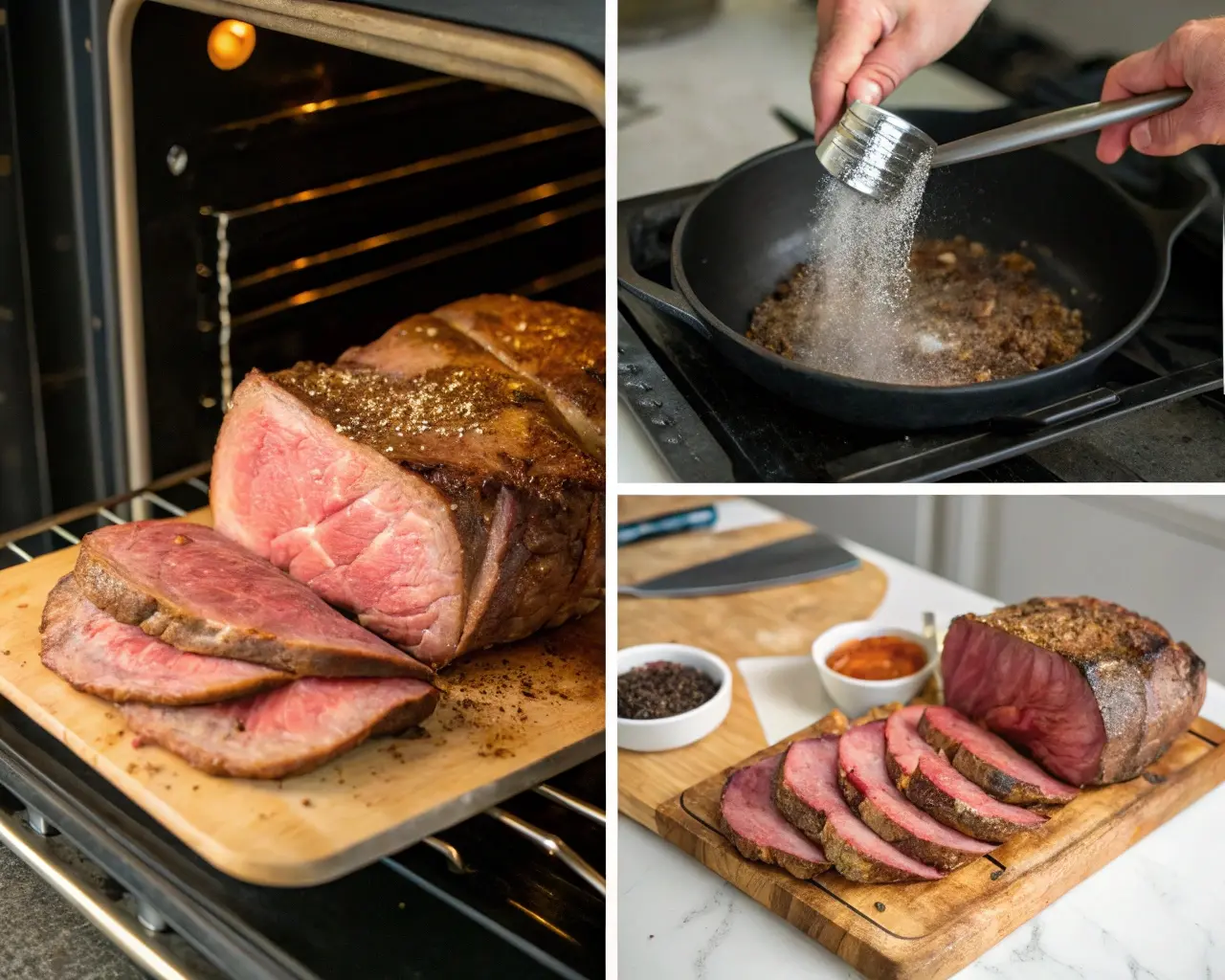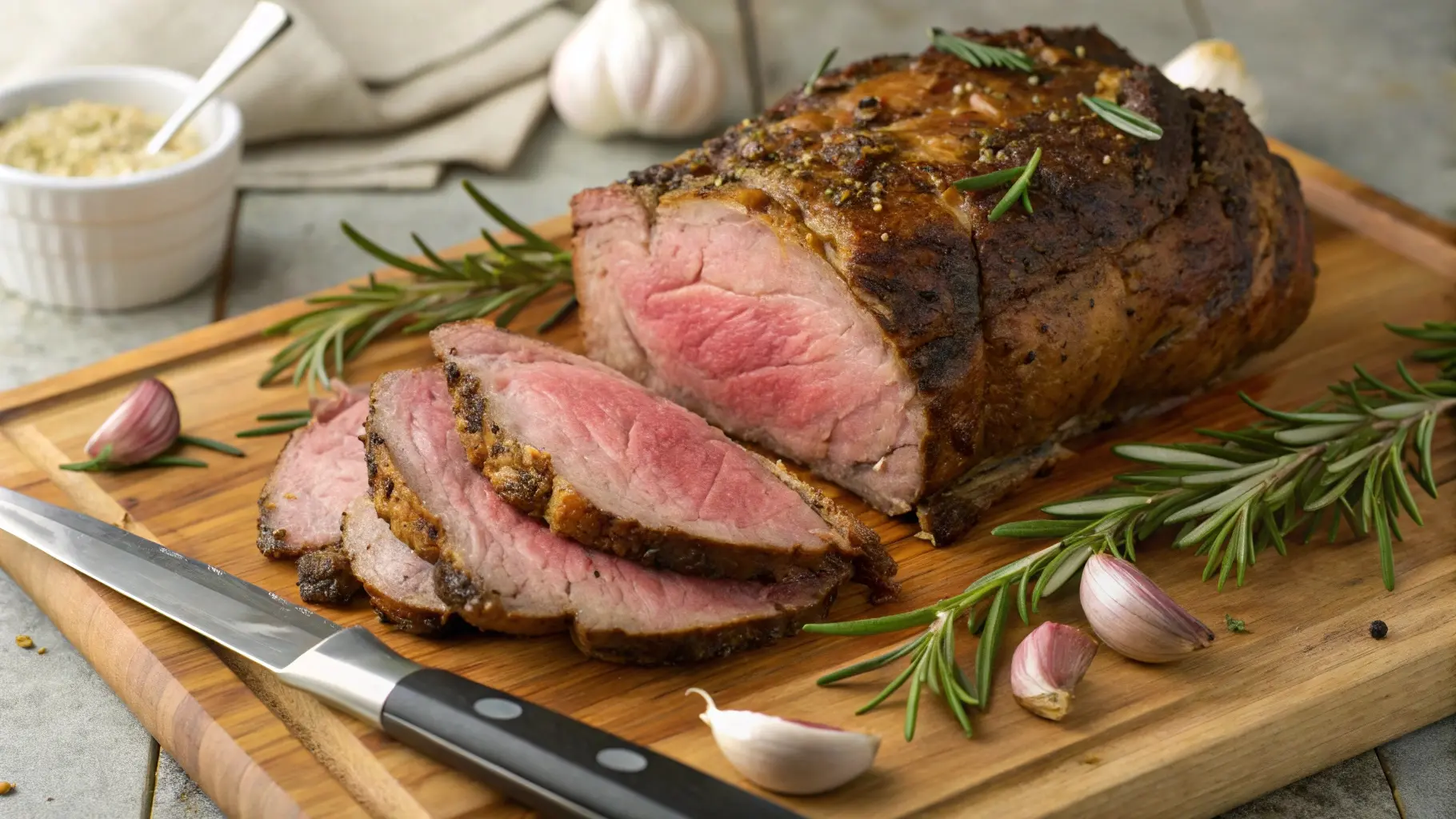Few dishes scream celebration quite like a ribeye roast recipe. With its rich marbling, melt-in-your-mouth tenderness, and deep, beefy flavor, it’s no wonder this cut has become a favorite for family dinners, holidays, and special occasions. Traditionally, ribeye roast traces its roots back to classic European roasting techniques, where slow-cooked meats were the highlight of festive tables. Over time, it evolved from a simple Sunday roast to a show-stopping centerpiece, thanks to creative seasoning blends and modern cooking methods. Whether you’re a first-timer or a seasoned home cook, this ribeye roast recipe will guide you to achieving the perfect balance of crispy crust, juicy center, and unforgettable flavor. So, grab your apron—let’s get roasting!
Table of Contents
Selecting the Perfect Ribeye Roast

Bone-In vs. Boneless Ribeye Roast
Before you jump into cooking, let’s talk about picking the right cut. A ribeye roast recipe can be made with either a bone-in or boneless roast, and each has its own perks.
- Bone-In Ribeye Roast: The bone helps insulate the meat, leading to a slightly richer flavor and a juicier texture. However, it takes a little longer to cook and can be trickier to carve.
- Boneless Ribeye Roast: Easier to slice and cook evenly, this option is great for those who prefer simplicity. It may not have the same depth of flavor as bone-in, but with the right seasoning, it still turns out fantastic.
Understanding Marbling and Meat Grades
The secret to a tender, flavorful ribeye roast? Marbling—those tiny white flecks of fat throughout the meat. The more marbling, the juicier and more buttery the roast will be.
- USDA Prime: The highest quality, with the most marbling (and a higher price tag).
- USDA Choice: A step down from Prime but still well-marbled and tender.
- USDA Select: Leaner, less marbling, and not as tender—best for those who prefer a firmer texture.
How Much Ribeye Roast Per Person?
You don’t want to run out of meat—or have way too much left over. A good rule of thumb is:
- Boneless roast: ½ pound per person
- Bone-in roast: ¾ pound per person
Planning a feast? Grab a little extra—you’ll thank yourself when you have leftovers for sandwiches!
Preparing Your Ribeye Roast
Bringing the Roast to Room Temperature
Ever bite into a steak that’s cooked unevenly? That happens when you throw cold meat straight into the oven. Let your ribeye roast sit at room temperature for 1-2 hours before cooking. This ensures even cooking and a juicier result.
Seasoning Options for Ribeye Roast
Now, let’s talk flavor. A ribeye roast recipe doesn’t need a dozen spices—just a handful of good ingredients to let the beef shine.
- Simple Salt and Pepper Rub: Sometimes, less is more. A generous coat of kosher salt and freshly cracked black pepper brings out the meat’s natural flavor.
- Herb and Garlic Butter Infusion: Want a deeper, richer taste? Mix butter, minced garlic, rosemary, and thyme for a fragrant, mouthwatering crust.
Tying the Roast: Is It Necessary?
If your roast is uneven or has thinner ends, tying it with butcher’s twine keeps it in shape for even cooking. If it’s already compact, you can skip this step.
Once prepped, your ribeye roast is ready for the oven! Up next: the best cooking techniques for a tender, perfectly cooked roast.
Cooking Techniques for Ribeye Roast Recipe
Oven-Roasting Method
The best and most traditional way to cook a ribeye roast recipe is by roasting it in the oven. This method gives you a crispy, flavorful crust while keeping the inside juicy and tender.
High-Heat Searing
Start by preheating your oven to 450°F (232°C). This initial high heat helps develop a deep brown crust that locks in moisture. Place your seasoned ribeye roast in a shallow roasting pan with a rack, fat side up, and roast for about 15-20 minutes.
Reducing Temperature for Even Cooking
After the initial sear, lower the oven temperature to 325°F (163°C). This ensures the roast cooks evenly without drying out. The general rule of thumb is 15-20 minutes per pound, but always go by internal temperature rather than time.
Cooking Chart for Ribeye Roast Doneness
- Rare (Cool Red Center) – 120-125°F (49-52°C)
- Medium-Rare (Warm Red Center) – 130-135°F (54-57°C)
- Medium (Warm Pink Center) – 140-145°F (60-63°C)
- Medium-Well (Slightly Pink Center) – 150-155°F (65-68°C)
- Well-Done (Little to No Pink) – 160°F+ (71°C+)
Alternative Cooking Methods
Slow Cooker Approach
If you’re short on oven space, a slow cooker is a great alternative. Place the seasoned ribeye roast in a crockpot with beef broth, onions, and garlic, then cook on LOW for 6-8 hours until tender. The result? A juicy, pull-apart roast perfect for sandwiches or tacos.
Sous Vide Precision Cooking
Sous vide is for those who want precision. Simply vacuum-seal your ribeye roast, set your water bath to 130°F for medium-rare, and cook for 4-6 hours. Finish by searing it in a hot skillet for that signature crust.
Whichever method you choose, the key is monitoring temperature to avoid overcooking!
Determining Doneness and Resting the Roast
Using a Meat Thermometer
Guessing is risky when cooking a ribeye roast—it’s too delicious to mess up! Always use a meat thermometer to check doneness. Insert it into the thickest part of the roast, avoiding bones or fat pockets.
Doneness Levels Explained
Wondering what temperature to aim for? Here’s a quick guide:
- Rare: Cool red center, 120-125°F
- Medium-Rare: Warm red center, 130-135°F (Most popular choice!)
- Medium: Warm pink center, 140-145°F
- Medium-Well: Slightly pink center, 150-155°F
- Well-Done: No pink, 160°F+
If you want the juiciest results, pull the roast 5°F before your target temp, as it continues cooking while resting.
The Importance of Resting Meat
One of the biggest mistakes? Slicing too soon! After removing your ribeye roast from the oven, let it rest for at least 20-30 minutes. This allows the juices to redistribute, keeping every bite moist and flavorful.
For more cooking tips, check out our [recipes blog], where we share expert advice on making mouthwatering roasts!
Nutrition Facts for Ribeye Roast Recipe
If you’re curious about what’s on your plate, here’s a general nutrition breakdown per 6-ounce serving of a cooked ribeye roast recipe. Keep in mind that values may vary based on seasoning, marinades, and cooking method.
| Nutrient | Amount per 6 oz (cooked) |
|---|---|
| Calories | 450-500 kcal |
| Protein | 50g |
| Total Fat | 35g |
| Saturated Fat | 14g |
| Cholesterol | 130mg |
| Sodium | Varies (depends on seasoning) |
| Iron | 4.5mg (25% DV) |
Health Benefits of Ribeye Roast Recipe
A ribeye roast isn’t just tasty—it’s packed with high-quality protein, essential vitamins, and minerals like iron, zinc, and B12, which support energy and muscle health.
However, it’s also higher in fat, especially saturated fat, so moderation is key if you’re watching your intake. Pairing it with roasted veggies or a fresh salad is a great way to balance the meal.
For more healthy meal ideas, check out our [recipes blog] for inspiration!
Conclusion
There’s nothing quite like a perfectly cooked ribeye roast recipe. Whether you’re serving it for a holiday dinner, family gathering, or a special weekend treat, this roast delivers big on flavor, tenderness, and satisfaction.
Remember, choosing the right cut, seasoning well, and cooking to the perfect temperature make all the difference. And don’t forget the golden rule—let it rest before slicing!
Now that you’ve got everything you need, it’s time to fire up that oven (or slow cooker) and make some magic. Looking for more hearty meals? Check out our [recipes blog] for even more mouthwatering dishes!
Frequently Asked Questions
Is ribeye roast the same as prime rib?
Not exactly! Both come from the same section of the cow (the rib primal), but prime rib usually includes the bone, while ribeye roast is typically boneless. Prime rib is also often slow-roasted, while ribeye can be roasted or grilled.
How long should I cook a ribeye roast per pound?
A general rule of thumb is 15-20 minutes per pound at 325°F (163°C) after an initial high-heat sear. However, always rely on a meat thermometer instead of just time to ensure it’s cooked exactly how you like it.
Do I need to cover the roast while it’s cooking?
Nope! Keeping it uncovered helps develop a crispy, caramelized crust. If you cover it, you’ll trap moisture, which can soften the crust. However, if it starts browning too much, you can tent it loosely with foil.
Can I prepare a ribeye roast in advance?
Absolutely! You can season the roast a day ahead and let it sit in the fridge to enhance the flavor. If reheating, do so low and slow (250°F) to keep it juicy.

